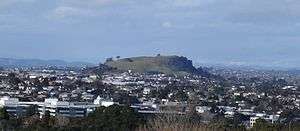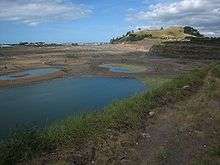Maungarei
Maungarei / Mount Wellington is a 135-metre volcanic peak located in the Auckland volcanic field of Auckland, New Zealand.[1] It is the youngest onshore volcano of the Auckland volcanic field, having been formed by an eruption around 10,000 years ago. It is the largest of Auckland's scoria cones and has a near-circular base with a flattish rim and three small fire-fountaining craters.[1][2] It is situated in the Mount Wellington suburb of East Auckland.
| Mount Wellington / Maungarei | |
|---|---|
| Mount Wellington | |
 Maungarei / Mount Wellington | |
| Highest point | |
| Elevation | 135 m (443 ft) |
| Coordinates | 36°53′35″S 174°50′47.6″E |
| Geography | |
| Location | Auckland, North Island, New Zealand |
| Parent range | Auckland volcanic field |
| Geology | |
| Volcanic arc/belt | Auckland volcanic field |
Maungarei / Mount Wellington was used as a pā, and its flanks, particularly on the eastern side, are covered in food storage pits and terraced house sites.[3]

Much of the old lava flow surrounding the mountain has been quarried for industrial aggregates, and the large quarry to the north of the mountain once produced 7% of New Zealand's roading aggregate.[2] The quarry has now closed and continues to be redeveloped for the Stonefields housing subdivision.[4]
The name Maungarei is translated as "the watchful mountain" or "the mountain of Reipae". Reipae is a Tainui ancestress who travelled to Northland in the form of a bird. Mount Wellington was named by colonists after the Duke of Wellington.[3]
In 1963, a 45,100 cubic meter reservoir was constructed near the summit of the cone. The largest at the time, this reservoir is still the fourth largest in the city and is currently used to supply the Saint Johns reservoir as well as the suburbs of Glen Innes, Saint Johns, Saint Heliers, Kohimarama and Glendowie.
In the 2014 Treaty of Waitangi settlement with the Tamaki Makaurau Collective of 13 Auckland iwi, the volcano was officially named Maungarei / Mount Wellington and ownership was vested to the collective. It is now co-governed by the collective and Auckland Council in common benefit of the iwi "and all other people of Auckland".[5][6][7][8][9][10]
In 2018 the summit of Maungarei became accessible to pedestrians only[11] with a barrier installed across the access road.

References
- Hayward, Bruce W.; Murdoch, Graeme; Maitland, Gordon (2011). Volcanoes of Auckland: The Essential Guide. Auckland University Press. p. 162. ISBN 978-1-86940-479-6.
- "Volcanoes of Auckland: Mt Wellington". Auckland Regional Council. Archived from the original on 11 February 2009. Retrieved 5 March 2009.
- Hayward, Bruce W.; Murdoch, Graeme; Maitland, Gordon (2011). Volcanoes of Auckland: The Essential Guide. Auckland University Press. p. 161. ISBN 978-1-86940-479-6.
- "Stonefields". Stonefields. Archived from the original on 1 November 2014. Retrieved 1 November 2014.
- Dearnaley, Mathew (27 September 2014). "Volcanic cones regain Maori names". New Zealand Herald. Retrieved 25 October 2014.
- "Ngā Mana Whenua o Tāmaki Makaurau Collective Redress Act 2014". New Zealand Legislation. Retrieved 25 October 2014.
- "Ngā Mana Whenua o Tāmaki Makaurau Collective Redress Act 2014 registration guideline" (PDF). Land Information New Zealand. Archived from the original (PDF) on 29 October 2014. Retrieved 25 October 2014.
- "NZGB decisions - September 2014". Land Information New Zealand. Archived from the original on 29 October 2014. Retrieved 25 October 2014.
- "Protection of tupuna maunga assured under ownership transfer". Auckland Council. Retrieved 25 October 2014.
- "New governance structure for treasured tūpuna maunga". Auckland Council. Retrieved 25 October 2014.
- "Maungarei/Mt Wellington fifth Auckland maunga to go car-free". Stuff. Retrieved 20 February 2019.
- Volcanoes of Auckland: A Field Guide. Hayward, B.W.; Auckland University Press, 2019, 335 pp. ISBN 0-582-71784-1.
Further reading
- City of Volcanoes: A geology of Auckland - Searle, Ernest J.; revised by Mayhill, R.D.; Longman Paul, 1981. First published 1964. ISBN 0-582-71784-1.
- Volcanoes of Auckland: The Essential guide - Hayward, B.W., Murdoch, G., Maitland, G.; Auckland University Press, 2011. ISBN 9781869404796.